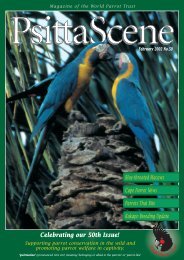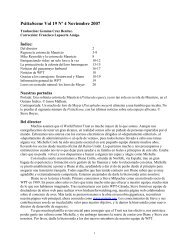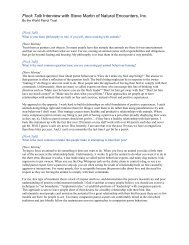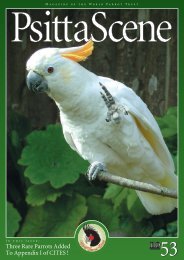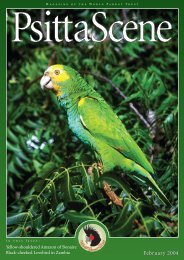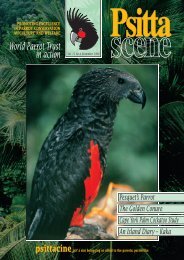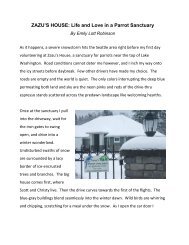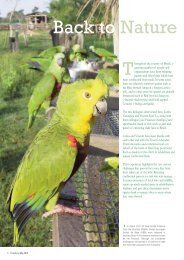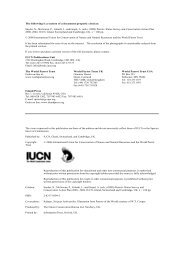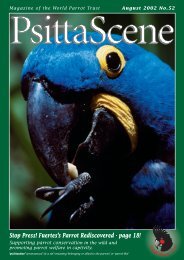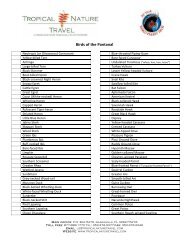PS 20 1 Feb 08.qxd - World Parrot Trust
PS 20 1 Feb 08.qxd - World Parrot Trust
PS 20 1 Feb 08.qxd - World Parrot Trust
Create successful ePaper yourself
Turn your PDF publications into a flip-book with our unique Google optimized e-Paper software.
What do volunteers to the project do?<br />
Basically a volunteer becomes part of the team<br />
and is involved in all aspects of the project and<br />
camp life (including washing, collecting fire<br />
wood, cooking, etc.). For the <strong>20</strong>07 field season<br />
our focus was the primary nesting season.<br />
Volunteers did 5 hour shifts monitoring active<br />
nest cavities, walking transects in the bush with a<br />
guide certified to walk in the "Big-5" area with<br />
guests, and preparing and cleaning research<br />
equipment. Volunteers joined the project for at<br />
least a month, and all expenses in camp were<br />
covered. All the volunteer needed to do was get<br />
to Maun and we would fly them out. The<br />
volunteers were mostly young students interested<br />
in ecology, coming from as far afield as the<br />
University of Arizona, USA.<br />
Life in the Okavango Wilderness is<br />
unpredictable and consequences when<br />
something goes wrong are absolute. We have to<br />
be extremely cautious in the way we do things.<br />
Nevertheless, most volunteers had diverse and<br />
life-changing experiences while working on the<br />
project. Among their stories were being charged<br />
by elephants, having lions kill a buffalo at a 10-<br />
hour nest observation site, sharing a shower with<br />
the local leopard, and warding off invasion by<br />
troops of baboons on the island. Thankfully, no<br />
one got hurt, only the local hyena when some<br />
shelves collapsed on him (actually I think the<br />
shelves were worse off than him).<br />
Thank you to all of you that worked so hard in<br />
setting up the camp, so patiently in the 10-hour<br />
observations, and so bravely on the bush walks,<br />
all in the name of parrot research and<br />
conservation. For me their involvement in the<br />
project was two-fold, whereby I wanted them to<br />
learn and form a personal relationship with the<br />
parrots while also appreciating the sense of place<br />
in a wilderness area away from all outside<br />
influence.<br />
In this part of Africa the safest place to stare<br />
through the spotting scope doing nest observation is<br />
from the roof of the LandRover.<br />
Project volunteers have exciting and unpredictable<br />
experiences while immersed in the project and the<br />
surroundings. This very relaxed leopard lounging<br />
on the deck outside the shower definitely spices up<br />
the bathing experience.<br />
What were your major results?<br />
Based on observations made between <strong>20</strong>04<br />
and <strong>20</strong>07 it became clear that avoiding interspecific<br />
competition by choosing specific<br />
seasonal food item and breeding strategies<br />
was central to answering a fundamental<br />
question put forward at the onset of the<br />
project: What factors enable P. meyeri to be<br />
so "successful" in its natural habitat? During<br />
the first two years of the Meyer's <strong>Parrot</strong><br />
Project we focussed on their feeding ecology,<br />
habitat preferences and general behaviour<br />
(e.g. breeding seasons, preening, allopreening,<br />
roosting, etc.) for correlation with<br />
rainfall seasonality, resource abundance, and<br />
the annual flood regime in the study area. In<br />
<strong>20</strong>06, I did data analysis at the University of<br />
California, Berkeley, in Prof. Steve<br />
Beissinger's Lab, raised funds and did project<br />
design for the <strong>20</strong>07 field season. The time in<br />
Berkeley revolutionised the way I look at<br />
ecological research and made my return to<br />
Vundumtiki a necessity.<br />
Major findings of the three years in the field<br />
include:<br />
· Meyer's parrots track resources based on<br />
abundance and avoiding competition with<br />
other frugivorous birds and primates. They<br />
vocalize when they find suitable food trees<br />
and target seeds from unripe fruits and<br />
leguminous posts that are inaccessible to<br />
other seed predators;<br />
· They can open the extremely hard nut cases<br />
of the Marula (Scherolcarya birrea), Real Fan<br />
Palm (Hyphaene petersiana), and Baobab<br />
(Adansonia digitata) fruits, thus gaining<br />
exclusive access to the protein rich seeds.<br />
This behaviour has not been observed in<br />
other birds in the Okavango Delta or<br />
Poicephalus parrots elsewhere in Africa;<br />
· Breeding was observed throughout the year,<br />
however, 95% of the breeding activity fell<br />
within the period March - July (i.e. the winter<br />
months). This seemed to be synchronous<br />
with the end of the wet season, the onset of<br />
the flood, the cessation of breeding activity<br />
in the Burchell's Starling (Lamprotornis<br />
australis) (thus avoiding competition with this<br />
large, aggressive cavity nesting bird species)<br />
and a peak in the infestation levels of<br />
parasitic larvae in the Marula fruit (Sclerocarya<br />
birrea), Terminalia sericea pods, Bushwillow<br />
pods (Combretum hereronse) and Mopane pods<br />
(Colophospermum mopane) - a food source they<br />
eat almost exclusively<br />
Please contact me on boyes@africaskyblue.org<br />
in order to obtain information on future peerreviewed<br />
publications coming out later this year.<br />
<strong>Feb</strong>ruary <strong>20</strong>08 PsittaScene 9




